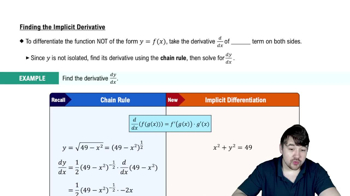Table of contents
- 0. Functions7h 52m
- Introduction to Functions16m
- Piecewise Functions10m
- Properties of Functions9m
- Common Functions1h 8m
- Transformations5m
- Combining Functions27m
- Exponent rules32m
- Exponential Functions28m
- Logarithmic Functions24m
- Properties of Logarithms34m
- Exponential & Logarithmic Equations35m
- Introduction to Trigonometric Functions38m
- Graphs of Trigonometric Functions44m
- Trigonometric Identities47m
- Inverse Trigonometric Functions48m
- 1. Limits and Continuity2h 2m
- 2. Intro to Derivatives1h 33m
- 3. Techniques of Differentiation3h 18m
- 4. Applications of Derivatives2h 38m
- 5. Graphical Applications of Derivatives6h 2m
- 6. Derivatives of Inverse, Exponential, & Logarithmic Functions2h 37m
- 7. Antiderivatives & Indefinite Integrals1h 26m
- 8. Definite Integrals3h 25m
4. Applications of Derivatives
Implicit Differentiation
Problem 3.8.50a
Textbook Question
45–50. Tangent lines Carry out the following steps. <IMAGE>
a. Verify that the given point lies on the curve.
(x²+y²)²=25/4 xy²; (1, 2)
 Verified step by step guidance
Verified step by step guidance1
Substitute the point (1, 2) into the equation (x² + y²)² = (25/4)xy² to check if it satisfies the equation.
Calculate x² + y² for the point (1, 2) to find its value.
Square the result from the previous step to find (x² + y²)².
Calculate (25/4) * x * y² using the coordinates of the point (1, 2).
Compare the two results to verify if they are equal, confirming that the point lies on the curve.
Recommended similar problem, with video answer:
 Verified Solution
Verified SolutionThis video solution was recommended by our tutors as helpful for the problem above
Video duration:
2mPlay a video:
Was this helpful?

 5:14m
5:14mWatch next
Master Finding The Implicit Derivative with a bite sized video explanation from Nick
Start learningRelated Videos
Related Practice



